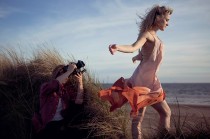Artist Alana Tyson (pictured above) was born in Calgary, Canada. She graduated from the Alberta College of Art and Design in 2006, with a BFA (Hons) degree in Painting. She moved to the UK in 2007 and currently lives in North Wales. She has exhibited internationally and in the UK. Recent exhibitions include a solo show at Oriel Davies testbed and Djanogly Gallery, Nottingham as part of World Event Young Artists. She was recently awarded an a-n Magazine re:View Bursary to assist her in pursuing new work. Here she tells us about creating her work…
For the past 7 years, I have been working on a series that grew out of explorations of developing a relationship with my late great-grandmother; sparked by a photo of her wearing a heavy wool coat. I started exploring the material lining of that coat with the realisation that I was predominantly interested in intimate interior spaces. Constructed of hand-sewn lining fabric, my artworks are reminiscent of coffin lining, chocolate boxes, and visceral entrails of the body. These pieces give import to that which is normally hidden away, both literally as in the above references and as a metaphor for the “soul”. The phrase “it’s what’s on the inside that counts” (or really the hypocrisy of it in western society) has become a central theme in my practice. The resultant manipulated fabric series has moved from small works confined to the stretcher frame into immersive and organic installation pieces.
My most recent exhibition was at Oriel Davies in Newtown, Wales. I was really excited to exhibit in Oriel Davies’ testbed space (for new and experimental work) because it is so wonderfully small! I had been looking for a confined space like this for quite a while because I wanted to be able to create a completely immersive experience for the viewer without having to get into building false walls. Crafts Magazine wrote of the exhibition:
“Part textile installation, part conceptual art, Tyson’s work transforms the gallery into a silent, richly lined, enclosed world. She’s inspired by secret, inner spaces and for this show, called Interior, Tyson uses swathes of elaborately pleated fabric which references the linings of coffins or chocolate boxes. The results are faintly disturbing and… can also be seen as a more sinister padded cell.”
I actually studied painting at art school though I hardly touched a paintbrush for my final year. This had quite a strong influence on my artwork; the pieces isolate a seductive sculptural language that seeks to rest between something 3-dimensional, yet is simultaneously flat, almost painterly. I am slowly finding myself pushing further into the 3-dimensional realm and the piece at Oriel Davies actually detached from the corners of the room.
Every time I make a new piece I try to think of how it is going to move on from the last one. I can now look back at the series and see each progression. Currently, I am thinking about the pieces peeling further off the walls and more possibilities with confined spaces. I am working on pieces for a show this summer at Bocs, an artist-run space in Caernarfon; I am very excited about what was the changing room in the building’s previous life and how I can use the space.
Once I have an idea of the piece I am going to make I gather my materials, lightweight muslin, lining fabric and lots of strong thread. I use the machine to sew together large pieces of fabric but once that is done the entire piece is stitched by hand. I manipulate the lining material manually, encouraging it to ripple naturally and then tack the folds into place with tiny stitches against the backing material. It is really important to me that the stitches are not visible. The suggestion of using glue has been made in the past but I am very resistant to it; it is stiff and once the fabric is wet it moves in a completely different manner. These pieces take quite a long time to make; the installation Inscape for RED Gallery in Hull (2009) was 18m long and took a year to create.
With the larger works I don’t actually get to see them fully until they are installed so I draw plans of the room (accurate measurements are very important) and with Oriel Davies I constructed a small maquette.
I was lucky to find a space big enough to lie out the Oriel Davies piece so I could accurately check my measurements before the install. This is not always possible and I spend the installation holding my breath, just praying that the final artwork looks something like what I envisioned.
Even with this, I feel like I end up holding a lot of information in my head and just have to trust my instincts. I don’t plan the flow of the stitching at all and just let that develop as I go, though I do often try to make problems for myself such as intentionally starting in a middle section with not enough fabric so that tension is created in the final piece.
The transportation of my work can be a huge concern that is easy to forget until you find yourself trying to ship a 4m2 stretcher frame. I figured out with my solo show at RED Gallery, Hull that I could directly attach my artworks to the wall using a staple gun. I fold over the raw edges and hide the staples in the folds of the fabric, completely removing any evidence of mounting. This simple discovery was probably one of the biggest revelations with my process and allowed me to go so much bigger and really experiment with organic shapes. I am now only confined by the exhibition space, though with the show at Oriel Davies I even pushed beyond that a bit and allowed my work to creep out the doorway.
More: Website





















Comments